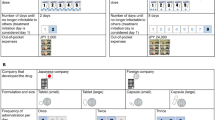Abstract
The purpose of this study was to determine the magnitude of the difference in patient preferences/utility for intravenous (IV) ganciclovir compared with oral ganciclovir for maintenance treatment of cytomegalovirus (CMV) retinitis.
We used a cross-sectional, interviewer-administered time trade-off (TTO) exercise with hypothetical health state descriptions, based upon data from clinical trials and the published literature. The study was conducted in a private clinic in Sydney, Australia, specialising in the care of people with HIV. A total of 80 individuals with HIV infection who had not developed AIDS were administered the TIO instrument. The main outcome measure was the difference between each respondent’s utility score for oral and IV ganciclovir maintenance therapy.
When the 80 HIV-positive patients were presented with information on drug efficacy, adverse effects and mode of administration, 60 (75%) preferred oral ganciclovir, 4 patients preferred IV ganciclovir, and 16 were indifferent, The median utilities were 0.837 (oral ganciclovir) and 0.475 (IV ganciclovir). The difference in rankings was statistically significant by Wilcoxon’s signed-ranks test (Z = -6.69, P < 0,00005)
The median utility scores suggest that, all other things being equal, individuals with HIV infection would prefer an oral formulation of ganciclovir to IV administration in the event of CMV retinitis infection.
Similar content being viewed by others
Reference
Lcnderking WR. Gelber RD. Cotton DJ. et al. Evaluation of the quality of life associated with zidovudine treatment in asymptomatichuman immunodeficiency virus infection. N Engl J Med 1994: 330: 738–43
Wu AW. Rubin HR. Mathews WE. et al. Functional status and well-being in a placebo-controlled trial of zidovudine in earlyAIDS-related complex. J Acquir Immune Defic Syndr 1993:6:452
De Boer JB. van Dam FSAM. Sprangers MAG. et al. Longitudinal study on the quality of life of symptomatic HIV-infectedpatients in a trial of zidovudine versus lIdovudine and interferon-alpha. AIDS 1993: 7: 947–53
Gelher RD. Lenderking WR. COllon DJ. et al. Quality-of-Iife evaluation in a clinical trial of zidovudine therapy in patientswith mildly symptomati. HIV infection. Ann Intern Med1992: 116: 961–6
Wu AW. Mathews WE. Brysk LT. et al. Quality of life in a placebo-controlled trial of zidovudine in patients with AIDSand AIDS-related complex. J Acquir Immune Delic Syndr1990: 3: 683–90
Revicki DA. Simpson KN. Wu AW. et al. Evaluating the quality of life associated with rifabutin prophylaxis for Mycobacterium avium complex in persons with AIDS: combining Q-TWiST and multiattribute utility techniques. Qual Life Res 1995; 4:309–18
De Boer JB. van Dam FSAM. Sprangers MAG. Health-related quality-of-life evaluation in HIV-infected patients: a reviewof the literature. Pharmacoeconomics 1995: 8: 291–304
Glasziou PP. Simes RJ. Gelber RD. Quality adjusted survival analysis. Stat Med 1990; 9: 1259–76
Drew WL. Ives D. Lalezari JP. et al. Oral ganciclovir as maintenance treatment for cytomegalovirus retinitis in patientswith AIDS. N Engl J Med 1995; 333: 615–20
Drummond MF. Stoddart GL. Torrance GW. Methods for the economic evaluation of health care programmes. New York: Oxford Medical Publications. 1987
Kane RL. Methodology for measuring health-state preferences-I: measurement strategies. J Clin Epidemiol1989: 42: 345–54
Patrick DL. Starks HE. Cain KE. et al. Measuring preferences for health states worse than death. Med Decis Making 1994;14: 9–18
Llewellyn-Thomas H. Sutherland HJ. Tibshirani R. et al. Describing health stales: methodologic issues in obtaining valuesfor health Slates. Med Care 1984: 22: 543–52
Patrik DL. Erickson P. Health status and health policy. New York: Oxford University Press. 1993: 164–80
Froberg DG. Kane RL. Methodology for measuring health-state preferences-III: population and context effects. J Clin Epidemiol1989: 42: 585–92
Furlong W. Feny D. Torrance GW. et al. Guide to design and development of health-state utility instrumentation. Hamilton(0nt: McMaster University). 1990: 90–9 (CHEPA workingpaper series)
Sackeu DL. Torrance GW. The utility of different health states as perceived by the general public. J Chronic Dis: 1978; 31:697–704
Fisher LD. van Belle G. Biostatistics: a methodology for the health sciences. New York: John Wiley & Sons. Inc 1993:159:310
Author information
Authors and Affiliations
Corresponding author
Rights and permissions
About this article
Cite this article
Johnson, E.S., Sullivan, S.D., Mozaffari, E. et al. A Utility Assessment of Oral and Intravenous Ganciclovir for the Maintenance Treatment of AIDS-Related Cytomegalovirus Retinitis. Pharmacoeconomics 10, 623–629 (1996). https://doi.org/10.2165/00019053-199610060-00008
Published:
Issue Date:
DOI: https://doi.org/10.2165/00019053-199610060-00008




